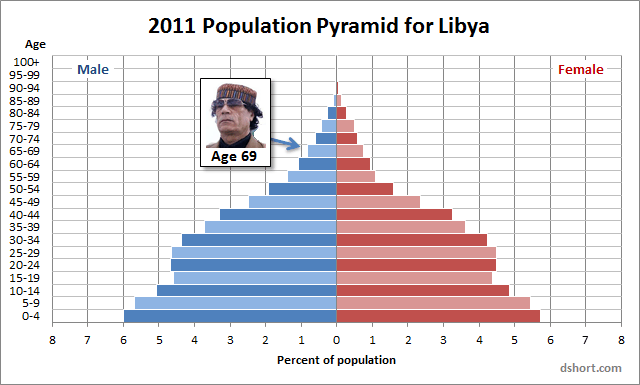While the US and Europe have remained fixated on the simmering sovereign debt crisis in Euroland, the Arab world has been experiencing waves of demonstrations, protests and civil wars that have seen the fall of three major regimes thus far in 2011, with several others struggling to find equilibrium.
The underlying forces behind the Arab Spring are complex and vary from country to country. But a key factor is demographics, as a glance at the population pyramids below suggests.
A common denominator of the three is an aging ruling party unable to control a population bulge of young adults afflicted by high unemployment, food inflation, corruption, an absence of political freedoms and generally poor living conditions. 


The three pyramids above differ somewhat from one another, especially the pattern of contracting growth in Tunisia. But the three exhibit the common demographic of young adult males in the numbers necessary to mount a successful overthrow of the government.
Earlier this month I posted a commentary on Boomer Demographics: The Shift Ahead, which was an outgrowth of my presentation at the Retirement Industry Income Association (RIIA) 2011 Fall Conference.
My focus on demographics, as in the Boomer piece, has generally explored the financial implications of an aging population on government debt and the slow-motion ripple effect on markets and the economy. I'll have more on this topic next week in some commentaries on world demographics, especially Europe. But sometimes the impact of demographics can be sudden and explosive, as we've seen in the Arab Spring.
- English (UK)
- English (India)
- English (Canada)
- English (Australia)
- English (South Africa)
- English (Philippines)
- English (Nigeria)
- Deutsch
- Español (España)
- Español (México)
- Français
- Italiano
- Nederlands
- Português (Portugal)
- Polski
- Português (Brasil)
- Русский
- Türkçe
- العربية
- Ελληνικά
- Svenska
- Suomi
- עברית
- 日本語
- 한국어
- 简体中文
- 繁體中文
- Bahasa Indonesia
- Bahasa Melayu
- ไทย
- Tiếng Việt
- हिंदी
Libya, Ghaddafi and the Arab Spring
Published 10/24/2011, 06:08 AM
Updated 07/09/2023, 06:31 AM
Libya, Ghaddafi and the Arab Spring
Latest comments
Loading next article…
Install Our App
Risk Disclosure: Trading in financial instruments and/or cryptocurrencies involves high risks including the risk of losing some, or all, of your investment amount, and may not be suitable for all investors. Prices of cryptocurrencies are extremely volatile and may be affected by external factors such as financial, regulatory or political events. Trading on margin increases the financial risks.
Before deciding to trade in financial instrument or cryptocurrencies you should be fully informed of the risks and costs associated with trading the financial markets, carefully consider your investment objectives, level of experience, and risk appetite, and seek professional advice where needed.
Fusion Media would like to remind you that the data contained in this website is not necessarily real-time nor accurate. The data and prices on the website are not necessarily provided by any market or exchange, but may be provided by market makers, and so prices may not be accurate and may differ from the actual price at any given market, meaning prices are indicative and not appropriate for trading purposes. Fusion Media and any provider of the data contained in this website will not accept liability for any loss or damage as a result of your trading, or your reliance on the information contained within this website.
It is prohibited to use, store, reproduce, display, modify, transmit or distribute the data contained in this website without the explicit prior written permission of Fusion Media and/or the data provider. All intellectual property rights are reserved by the providers and/or the exchange providing the data contained in this website.
Fusion Media may be compensated by the advertisers that appear on the website, based on your interaction with the advertisements or advertisers.
Before deciding to trade in financial instrument or cryptocurrencies you should be fully informed of the risks and costs associated with trading the financial markets, carefully consider your investment objectives, level of experience, and risk appetite, and seek professional advice where needed.
Fusion Media would like to remind you that the data contained in this website is not necessarily real-time nor accurate. The data and prices on the website are not necessarily provided by any market or exchange, but may be provided by market makers, and so prices may not be accurate and may differ from the actual price at any given market, meaning prices are indicative and not appropriate for trading purposes. Fusion Media and any provider of the data contained in this website will not accept liability for any loss or damage as a result of your trading, or your reliance on the information contained within this website.
It is prohibited to use, store, reproduce, display, modify, transmit or distribute the data contained in this website without the explicit prior written permission of Fusion Media and/or the data provider. All intellectual property rights are reserved by the providers and/or the exchange providing the data contained in this website.
Fusion Media may be compensated by the advertisers that appear on the website, based on your interaction with the advertisements or advertisers.
© 2007-2024 - Fusion Media Limited. All Rights Reserved.
